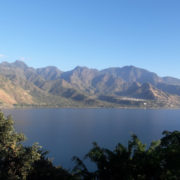Ending Exploitation Then, came Guatemala.
Ending Exploitation And then, came Guatemala. These words are probably the most powerful words that have spoken to me in a long time.

Lake Atitlan Weaving School
As a full-time traveler in developing countries, I used to always be on the lookout to source cheap local crafts which I could import back to my country and sell with a 200% markup or more with of course bargaining for a cheaper wholesale price. As part of a consuming and fast fashion generation, I was always been on the hunt for inexpensive clothing to fill my own wardrobe and the thought would always cross my mind: “How can I resell these things back home at a 200% markup?”
Torn between not wanting to share my wardrobe and making money, I never acted on this thought and 4 years later I am glad I didn’t. What I have discovered in the past year about the fashion industry infuriates me but more than the fury, I feel like a hypocrite because I still find myself with the urge to splurge (well in my world splurge means 20$) but not to add fuel to the increasing fast fashion flame.

Ethical Fashion Brand and Guatemala Textile Sourcing
My second-hand store shopping sprees began on the streets of Vietnam. As my 1.78cm height seemed to make me a friendly giant in this unique country, I managed to warm my legs with second-hand clothing which also made my purse remain heavy. I found some great vintage pieces which are one of a kind and I knew I wouldn’t see at least 5 other girls wearing the same t-shirt as me. I felt good knowing I was giving clothes a second life and not supporting big corporations.
Ending Exploitation
Having bought plenty of dresses off the streets of India, I began learning what material lasts more than 5 washes and what doesn’t- FYI, not many aren’t going to break the bank. It wasn’t until Bali, that I saw many Westerners purchasing the same Indian material, creating their own designs, taking advantage of the cheap labor, and selling these clothes for 200-300$. Not only couldn’t I afford these prices but the moment I brought my fingertips to the material I had a flashback of unraveling my entire dress by tugging on one thread.
It was this time when I explored my inner DIY and began making my own jewelry, not to sell only for personal use I will never forget my second or third trip to crafters heaven store when a western lady said to me “Just buy the materials, have a local Balinese make the products and enjoy your holiday whilst they work and you make money selling the pieces”. I quickly picked my jaw off the floor, sneaked an uneasy look at the local with her, and excused myself from the uncomfortable situation. Replaying her words over and over on my way scooter ride home it was as if my rose-tinted glasses had been removed and I started to realize what I had been a part of my entire life.
Ending Exploitation
A few weeks later, I met a beautiful Hungarian girl who told me she has a clothing label, sources all of her materials locally, and gets all her items made in Bali, due to my newfound information and mission to support local artisans, I drilled her with questions “how much do you pay your workers? Are their working conditions above average? What material do use?”
To my delight, she was a part of the Fashion Revolution and after starving myself saving my food budget I bought one of her 100% cotton dresses and I was a changed woman. I remember thinking “I want all of my purchases to feel this light on my skin and soft on my conscience”.
Ending Exploitation And then, came Guatemala.

Ethical Fashion Brand and Guatemala Textile Sourcing
I was blown away by these weaving women but I was even more intrigued by the natural dyes they use. But once again, I not only saw these women not receiving what they should for their art but other local women were selling similar garments on the street at a much cheaper price made of cheaper material, which I later learned are made in sweatshops.
Determined to live an ethical fashion lifestyle, I started doing research on how I can become a part of this world and I was fortunate enough to be introduced to James running Ethical Fashion Guatemala. He showed me how many artisans are not only getting ripped off by tourists but how any “entrepreneurs” were reselling the weaver’s garments at a ludicrous price online, after haggling with the artisans basically making their art form for free.

Ethical Fashion Brand and Guatemala Textile Sourcing
This isn’t an easy transition for us fast fashion consumers, I get it. The temptation of buying that 15$ dress as opposed to the 60$ one seems like the devil and an angel are sitting on my shoulders but the thought that drives me to spend that little bit extra is who I am purchasing it from. Why should we encourage the fast fashion lifestyle when we as consumers have the power to take control of our environment?
We can decide who gets our hard-earned money, and what clothes can transform us every day and unfortunately, it’s not the clothes that have a life span of 4 months and poisoned our rivers. Instead, our one purchase at a slightly higher price made with love will not only last longer but that sensation of knowing you have supported a hard-working artisan will last forever.


 Ethical Fashion Guatemala
Ethical Fashion Guatemala Ethical Fashion Guatemala
Ethical Fashion Guatemala
 Ethical Fashion Guatemala
Ethical Fashion Guatemala
 Ethical Fashion Guatemala
Ethical Fashion Guatemala
 Ethical Fashion Guatemala
Ethical Fashion Guatemala
Leave a Reply
Want to join the discussion?Feel free to contribute!